I think I saw an honest to goodness sign of spring this weekend around Mr. Neil's. I did a little driving to look for golden eagles again and I was stunned by the number of horned larks I flushed as I drove along the country roads.
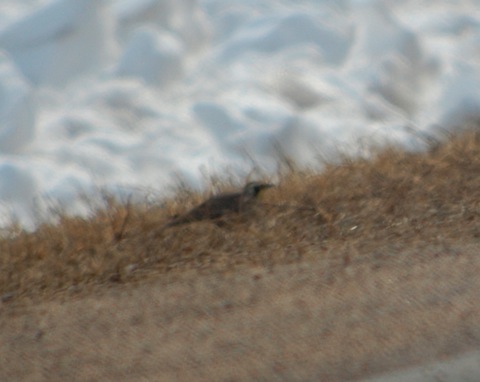
This is a terrible photo of a horned lark--heat shimmer coming off my car does not make for good digiscoping--even with a window mount for my scope. You might be seeing horned larks in your area if you drive down rural roads. Horned larks are commonly seen but if you don't know what to look for, you don't know that they are there. When you see brown birds flush away from a rural road, watch for dark stripes on either side of the tail as they fly--that's a horned lark. They are one of the first birds to return to Minnesota and when you see them that means spring migration is on.
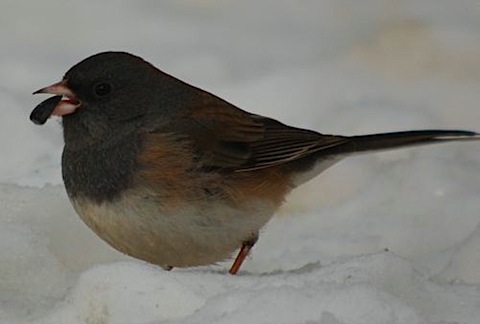
I took a moment to watch the juncos since their time is limited here and they will flock up and eventually head north to their breeding grounds. We have so much snow everywhere. I heard on Minnesota Public Radio that there's a 60% chance of big flooding of the Mississippi River this May and Harriet Island could be flooded. My national park's visitor center is in the Science Museum of Minnesota which is right across the Mississippi River from Harriet Island...should make for some interesting photos if it floods.
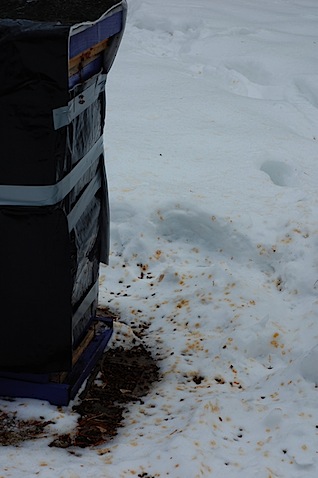
I was surprised to find Mr. Neil at home when I stopped by to take photos of the feeders--he travels more than I do. He checked the hives while I was in Panama and did a wee blog about it. He took me out Saturday so we could see them fly out in the warm weather. All of the hives had little flecks of dull gold dots around the hives. The girls had been coming out for a poop. Hans had been doing a good job of helping our hives this winter. He's been shoveling snow away from the entrances to hopefully help with the ventilation. We watched bees fly out of all four hives--even our red hive which is down to only 2 boxes instead of three like the other hives because she swarmed late in summer. I was surprised that all four were all still going despite some of our bone numbing freezing temperatures in January.
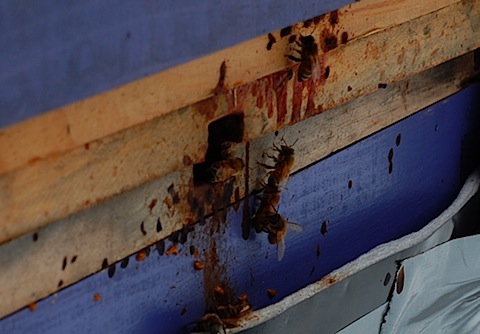
We know not to get too excited about this. Last winter at this time both our hives were in good shape and both died in late March so it ain't over til it's over. We discussed what our plan was. According to the bee class that I took, we should divide our hives this spring to prevent a swarm and save money by dividing one large hive in 2. If we actually get the Russians we ordered last year and are supposed to get this year...that could mean we'd have 9 - 10 hives this spring--YIKES.
Working with queens has been an exercise in heartache for us up to this point: queens arrive before we're ready and die in the cage, queens die in the divide process, new queens are ordered and hives still fail and they get combined into one angry hive. If you have a serious honey operation--dividing hives makes sense if all goes well--one colony becomes two. We don't have a money making honey operation. Neil and I talked about what could be so bad if our hives swarmed and the bees tried to strike out on their own into little feral colonies in his woods? We'd still have plenty of honey from the remaining hive and the feral colony would still pollinate his trees.
I think we will try and divide one hive but let the others go. We congratulated each other at our changing and easy going attitude towards bees. I don't think we're really going to name them anymore. Even if we do we tend to talk to each other about the hives in terms of their box color or in rare cases when a hive has a particular personality--like our ill-fated Lebowski hive (it was a total slacker hive and got robbed by another colony). Mr. Neil smiled that I was seeing the wisdom what he suggested all along--taking a Sue Hubbell approach to bees--the less you do to them, the better off they are. No personal involvement. We will appreciate their pollination, enjoy their honey and hand it out as gifts and watch their industrious nature towards survival with awe.
Then, we noticed a bee flying above us and land on the snow. The snow is so cold that once a bee lands on it, she struggles for about 60 seconds and then freezes to death. Mr. Neil scooped her up from the snow.
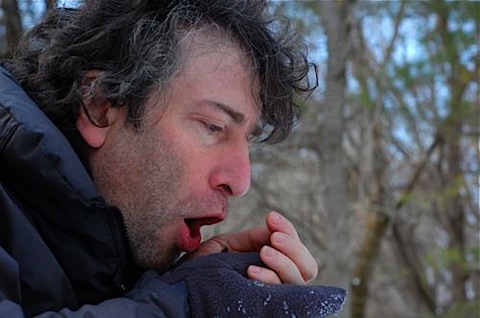
He brushed the snow away and breathed his warm breath on her to keep her going. She didn't seem to anxious to leave his glove. He walked over to the top of the hive to set her down, she stayed on his glove. He decided to leave his glove on the hive for the bee to get her bearings and stay warm on the dark fleece in the sun and hopefully when her returned later to retrieve the glove the bee would gone and presumably have flown into her hive. I smiled as we walked away and said, "I'm glad we just had this conversation about being less involved with our bees and you picked one up from the snow, gave mouth to bee heat, and left your glove behind for her."
He smiled and said, "And one has absolutely nothing to do with the other."
Indeed. Ah, spring.
